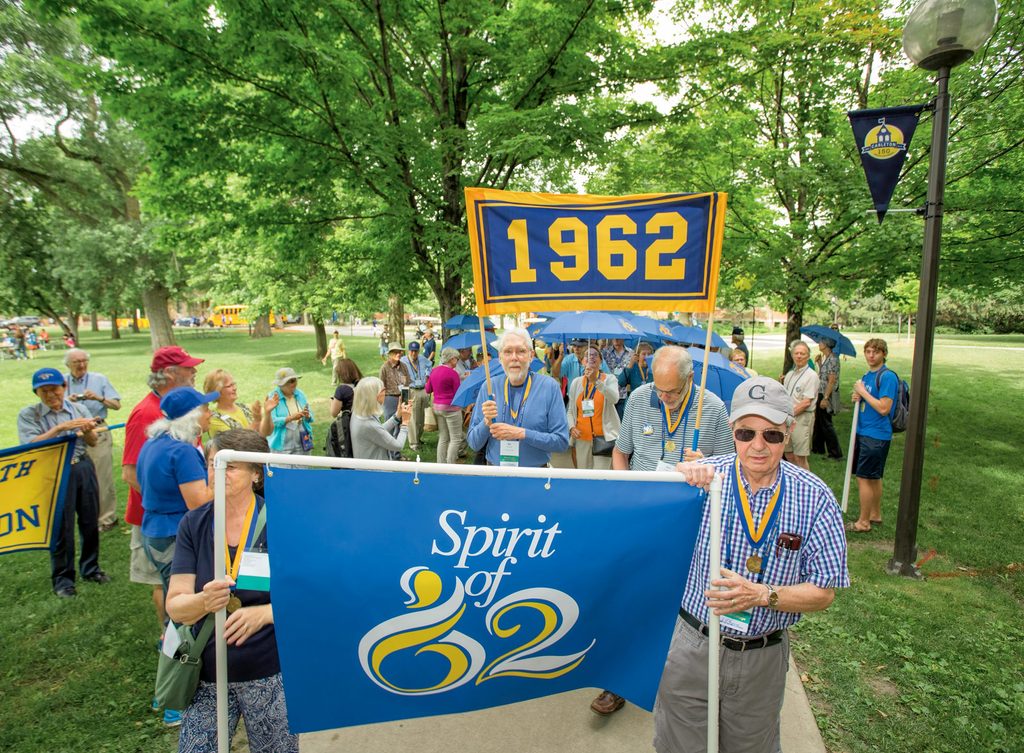From a meeting room in the Denver airport, a simple idea took flight. Thirty-two years later, the Alumni Annual Fund is still rising.

In early 1988, roughly a dozen Carleton alumni, representing classes from the 1930s through the 1980s and scattered from coast to coast, assembled at the Denver airport. Their mission: Determine whether a dedicated group of volunteers—supported by college staff—could drive significant alumni giving.
At the time, alumni engagement at Carleton wasn’t the juggernaut it is today. There were signs that participation was increasing, however. In summer 1987 the Class of 1962 raised $1.2 million, obliterating the 25th-reunion goal of $62,000 suggested by the college. A new president, Stephen R. Lewis Jr. P ’86, arrived on campus that fall, and when a group of alumni led by Alumni Council president Bill Feldt ’61 approached him about rebranding the Alumni Annual Fund (AAF), he was all ears.
“We knew it had to be an alumni-led effort,” says Kate Ligare ’72, one of the attendees at the Denver meeting. “The perceptions of alumni giving was somewhat of an afterthought in the development office before, and all of a sudden we were a small group of firebrands on the scene with a completely different vision to bring alumni together and make giving back to the college fun and meaningful.”
Very quickly, all involved agreed that Carleton should adopt a peer-to-peer solicitation model: every class would have a class agent, who would enlist four to five co-agents; they would then reach out to a few others, and so on. Solicitations for the annual fund would only come from volunteer classmates. (A few years later, an emphasis on classes making significant gifts at Reunion added another boost to the fund.)
“When a classmate asks you to give, it’s a lot different than if it’s somebody you don’t know,” says Charlie Lofgren ’62, P ’86, P ’87. “It’s harder to say no.”
Key to the fledgling fund’s success, Lofgren says, was the fact that President Lewis “let us fight our own battle” while quietly providing as much support as they needed. “We asked for the moon, and in very short order, we had 10 staff members supporting the alumni volunteers,” Ligare says. The college hired Tucky McCarthy Walker ’58 as the fund’s first executive director, and she and the new team moved into their own space, separate from the development office.
Walker’s group launched a strong marketing campaign and began collecting data to analyze which tactics influenced alumni giving. One of their most successful efforts was a brochure, called Carleton Compared, that they mailed to all alumni. It showed national rankings of colleges for academics and for alumni giving (Carleton was at the top the first list, Ligare noted, and the bottom of the other). Another success story was the printer’s proof—a simple list of everyone who donated in the past year that was also mailed to all alumni.
“The printer’s proof was a brilliant idea,” says David Diamond ’80. “We’d mail the list with a message that you had 30 days left to give and have your name added. Some alumni felt it was too competitive, but the numbers of people giving after it mailed were compelling.”
The team also enlisted New Yorker illustrator Jack Ziegler to draw a series of cartoons that encouraged Carls to give with a zeal that might have sounded insincere had the message not come from fellow alumni.
1933
The Alumni Annual Fund is created.
1987
The Class of ’62 runs its own landmark 25th-reunion campaign. The college asks them to try to raise $62,000; they raise $1.2 million and establish the Class of 1962 Scholarship Fund.
1988
Roughly a dozen alumni explore how to reinvigorate alumni giving and engagement with the college, and a new Alumni Annual Fund is launched.
1988
The first annual Alumni Annual Fund Volunteer Weekend—what will later become the Carleton Alumni Volunteer Experience (CAVE)—is held for class agents preparing to ask their peers for gifts to the annual fund.
1989
The first revamped Reunion is held, with each class designing its own program of events, the brand-new parade of classes, and a new all-class convocation; Alumni Association Awards for distinguished achievement and exceptional service were given for the first time to alumni in the reunion cycle.
2002
U.S. News & World Report ranks Carleton number one in alumni satisfaction—based on alumni giving to the annual fund—for the first
of many times.
2019
The AAF reaches a record $9,708,522.
Despite scattered skepticism among the alumni body, the initial group of organizers all felt confident the model would work—and so did President Lewis. “I knew the volunteer model was powerful, and the annual fund was key to all other fund-raising,” he says now. In fact, the energy and enthusiasm of the alumni volunteers led directly to increased trustee giving and planted the seeds for Carleton’s successful Assuring Excellence (1991–1998) and Breaking Barriers, Creating Connections (2004–2010) fund-raising campaigns as well as for the current Every Carl for Carleton campaign.
After raising $1.8 million in 1988, the AAF is expected to bring in $9.7 million in fiscal year 2020. Yet the fund’s biggest legacy, says Bill Craine ’70, P ’00, isn’t the dollars but how it gets people involved. “It creates ownership,” he says. “This is about us—we can make a difference at the school.”
President Steven Poskanzer agrees. “The annual fund at Carleton is an essential part of the college and of our current campaign,” he says. “The fact that the AAF is so strong is a testament to early volunteers’ vision and hard work—they paved the way for enormous support today.”

